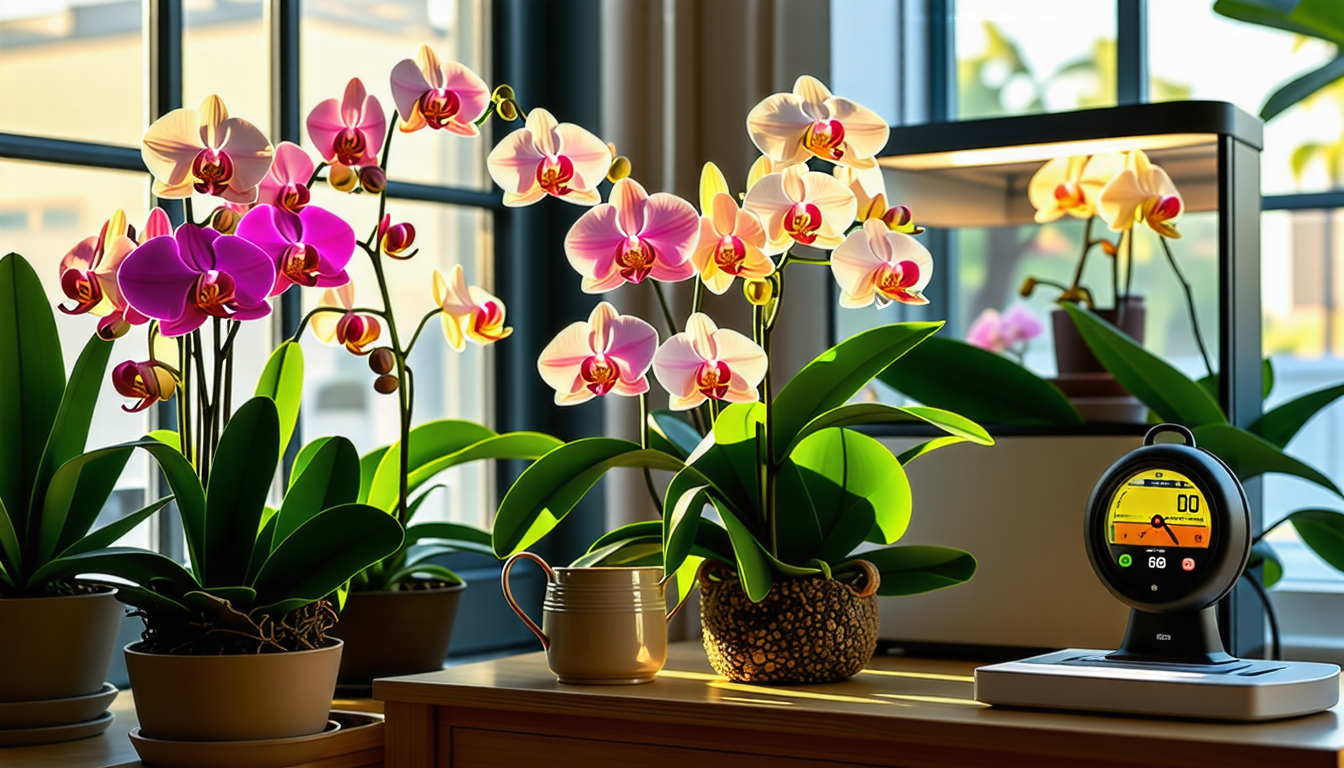|
IN BRIEF
|
Orchids, those exquisite jewels of the plant kingdom, thrive in a world of humidity that mimics their native tropical habitats. To cultivate these stunning blooms, understanding their humidity requirements is essential. Picture a moist, fragrant rainforest where the air is thick with life – this is the environment in which orchids flourish. Most orchids flourish best at a relative humidity ranging from 40% to a lush 70%, while certain varieties, like the enchanting Phalaenopsis, crave even more moisture, thriving in humidity levels as high as 75%. As a gardener, unlocking the secrets of humidity can mean the difference between wilting leaves and vibrant, long-lasting blooms. It’s time to delve into the fascinating world of orchid care and discover how to create the perfect, humid oasis for your treasured plants.

Orchids are truly the jewels of the plant kingdom, captivating us with their exquisite blooms and unique shapes. However, to keep these beautiful plants thriving, understanding their humidity needs is essential. Below, we’ll explore the ideal humidity levels for various orchid species and how to maintain them to ensure your orchids flourish.
Educate Yourself Continuously
Orchid care can be a learning process, and educating yourself continuously is vital. Consider joining local orchid societies, attending workshops, or exploring reputable online resources that offer valuable insights into orchid humidity needs.
Maintaining the right humidity levels is essential for the health and vitality of orchids. By understanding the specific needs of different species and implementing effective strategies to boost humidity, anyone can create a thriving environment for these stunning plants. Join the ever-growing community of orchid enthusiasts and cultivate a little piece of paradise right in your home!
How Climate Affects Humidity Needs
Orchids are native to diverse environments, with many originating from the lush, humid tropics. As a result, they are naturally adapted to high humidity levels. When kept in home conditions, particularly in drier climates or during the winter months, maintaining the right humidity becomes a challenge. In general, the American Orchid Society suggests that the ideal indoor humidity for orchids lies between 45% and 60%.
Temperature and Humidity Correlation
Temperature often goes hand-in-hand with humidity. Warmer air holds more moisture than cooler air, which means that the same humidity percentage translates to different absolute moisture levels depending on the temperature. Therefore, it’s vital to ensure that both humidity and temperature are balanced for optimal orchid health. Typically, a warm room with a moderate humidity level encourages healthy growth.

Understanding the humidity requirements for healthy orchids is crucial for orchid enthusiasts. These stunning plants, originating from tropical climates, generally thrive when humidity levels are maintained between 40% and 70% relative humidity. Specifically, types like the Phalaenopsis orchid prefer an environment boasting 55% to 75% humidity, ensuring vibrant blooms and robust growth.
Moreover, certain thin-leafed species and smaller orchids demand higher humidity levels, sometimes reaching 80%. In contrast, others such as Paphiopedilum can survive with humidity levels as low as 40%. Therefore, it’s essential to know the specific needs of your orchids to optimize their care.
To enhance humidity indoors, consider options such as setting up a humidity tray filled with water and pebbles, or even using a humidifier nearby. Air movement is also vital; establishing gentle airflow around your orchids can help maintain optimal moisture without creating stagnant conditions.
In summary, keeping an eye on humidity levels and using simple tools can significantly improve the health and beauty of your orchids.

Understanding the humidity requirements for healthy orchids is crucial for any enthusiast seeking to nurture these stunning plants. Since most orchids thrive in humidity levels ranging from 40% to 70%, creating an environment that mimics their native tropical habitats is essential. For delicate species like the Phalaenopsis, aiming for humidity closer to 55% to 75% can stimulate robust growth and vibrant blooms. Additionally, incorporating airflow helps prevent issues associated with stagnant air, promoting a healthy atmosphere. Consider utilizing humidity trays or humidifiers to elevate moisture levels in your home. Remember, providing the right humidity not only enhances your orchids’ beauty but also their overall health and vitality.
FAQ
What is the ideal humidity level for orchids?
R: The ideal humidity level for most orchids falls between 40% and 70%. Specific species, such as Phalaenopsis, thrive best in a humid environment ranging from 55% to 75%.
How does humidity affect the growth of orchids?
R: Humidity is crucial for the overall health of orchids. When humidity levels are too low, orchids can suffer from dehydration, leading to poor growth and even plant stress. Higher humidity helps support healthy leaf and root development.
Do all orchids require the same humidity levels?
R: No, not all orchids require the same humidity levels. While many prefer around 50-60% humidity, others may need as little as 40% or as much as 80%, depending on their native environments.
What can I do to increase humidity for my orchids at home?
R: You can increase humidity by using humidifiers, placing trays of water near your orchids, or grouping plants together to create a microclimate. Regular misting can also help raise humidity temporarily.
How can I tell if my orchids are not getting enough humidity?
R: Signs of insufficient humidity include browning leaf tips, wilting, and leaf drop. If your orchids appear stressed or have slowed growth, it might be a sign to check the humidity levels in your home.